The intercom system you choose will directly impact your renters’ experience and your bottom line as the building owner. So, which apartment intercom system with door release is right for you?
Companies offer everything from wired to wireless systems and audio to video intercoms—all with door-release mechanisms. On the surface, each appears appropriate for multi-tenant buildings, but not all are ideal. To make the right choice, you must assess their compatibility with existing infrastructure, ease of installation, long-term reliability, future-proof features, and cost-effectiveness.
But don’t worry; we’ll simplify your search by explaining how door-release intercoms work and outlining what to look for when choosing an apartment intercom system with these capabilities. Drawing on our experience, real-world case studies, and plenty of customer reviews, we’ll walk you through different types of systems, the best available today, key features, and those they lack. Whether you’re upgrading an existing system or installing one for the first time, this guide will answer every question you have about buying an apartment intercom system with door release.
You can also view our round-ups of the best apartment and business intercom systems for more information about specific products.
Table of Contents
- What is an apartment intercom with a door release mechanism?
- How Do Intercoms Release Doors?
- Types of Intercom Systems with Door Release Capabilities
- Costs involved in upgrading to an apartment intercom with door release
- FAQs About Buying an Apartment Intercom System with Door Release
Also, Read
- Guide to Apartment Intercom System
- How to Buy a Wireless Intercom System
- Video Intercom Systems with Door Release
- Video Intercom System – A Complete Guide
What is an apartment intercom with a door release mechanism?
An apartment intercom with door release is an intercom communication device that connects to existing door locks so tenants can remotely release the door lock for approved visitors. When a visitor approaches the door intercom, they dial a name from the directory to start an audio or video call.
With a modern intercom system, the tenant receiving a call can verify their guest’s identity before sending a door unlock command through their mobile app. This command physically sends a wired signal to release an electronic door lock. The door closes and locks behind the visitor after they enter your building. Watch how Swiftlane’s video intercom releases doors. But how does that door release mechanism actually work?
How Do Intercoms Release Doors?
Most apartment buildings have an electronic door lock that can work with a physical key but is also connected to a power source (e.g., 12 V DC power) that allows for remote unlocking. These systems have a relay, which controls the door lock’s power and acts like an electronic switch. When an electric lock gets power from a command, it releases that lock and opens the door remotely.
Electronic door locks are designed to be compatible with various intercom systems. This makes the door lock and intercom independent of each other. This modular design lets you easily upgrade your building’s access control system.
Apartment intercom systems are usually compatible with door-release mechanisms like magnetic locks (maglocks), electric strikes, and motorized deadbolts. These mechanisms control entry by responding to signals from the intercom, allowing or restricting access to your building.
Types of Door Release Mechanisms that Work with Modern Intercom Systems
Some door release mechanisms are manual, but most are electronic these days. Manual door release mechanisms include manual push or panic bars, lever handles, mechanical keypads, thumb-turn deadbolts, and mortise locks. Panic bars (sometimes called crash bars) are also electronic but are commonly manual. Electronic door release mechanisms include electric strikes, magnetic (maglocks), shear locks, drop bolts, solenoid locks, and wireless door release systems.
Of these manual and electronic door release mechanisms, push or panic bars, electric strikes, and maglocks are most commonly used in apartment buildings. Building owners often prefer maglocks and electric strikes over other mechanisms. This is because they are reliable, secure, simple to install, and easy to integrate with other systems (like intercoms).
However, manual push bars and panic bars are often found on the inside of exterior doors. This allows residents and guests to escape the building in an emergency.
How Does an Electric Strike Work?
An electric strike is an electronic device installed in the door frame. The electric strike replaces the regular strike plate, a metal fitting into which the latch extends when the door is locked.
When someone unlocks the door using their key, intercom, or access system, the electric strike temporarily releases that latch from the strike plate. This allows the door to open without turning a knob or pressing a bar.
How Does a Maglock Work?
A maglock uses a powerful electromagnet attached to the door frame and a metal plate on the door. When the magnet receives power, it holds that metal plate tightly, keeping the door locked. If you wish to unlock the door, the power to the magnet is cut, the magnetic hold is released, and the door opens without anyone physically turning the handle.
How Does a Panic Bar Work (Electric and Manual)?
You must install a panic or crash bar, which is a horizontal bar, inside a door for emergency exits. With the manual version, pushing the bar mechanically releases the door latch and quickly swings the door outward.
In the electric version, pushing the bar sends an electronic signal that releases the door lock. Many electric crash bar locks are automatically released when a fire alarm goes off, enabling swift building evacuation.
How Do I Know If My Door Lock Is Compatible with an Intercom System?
Many door release mechanisms will work with a modern intercom system. To determine whether that’s the case, check if an electronic release mechanism like an electric strike or maglock operates your lock.
Check the manufacturer’s specifications for the lock and intercom to see if they can work together. You can also contact a specialist who can guide you. They’ll assess voltage requirements, control inputs, and signal compatibility to ensure your existing door lock works with the new intercom.
How Do You Install an Electronic Door Lock?
You can install most electronic door release mechanisms by removing or modifying the existing door hardware. They also involve running wires from the door to the power supply and intercom system, and securing the mechanism.
Installation usually involves drilling, wiring, and sometimes chiseling. Depending on the system’s complexity and the type of door, the entire process takes 1 to 3 hours.
How Much Does It Cost to Install an Electronic Door Lock?
The cost to install an electric door lock, including labor and materials, generally ranges from $100 to $300 for an interior door and $300 to $2,000 for an exterior door. Higher-end systems and complex installations can cost more ($4,000+).
Why Would I Want an Intercom System with Door Release?
Installing an intercom system with door release is an easy way to make your building more secure. It empowers your residents to manage their visitors remotely and cut operating costs. It lets residents verify visitors through audio or video calls before remotely granting access.
These intercom systems eliminate the need for physical keys, manual entry, or door attendants who manage access to the building. Modern intercom systems make apartment buildings more attractive to quality tenants. Modern intercom systems can help in preventing intrusion and theft, offering accessible security features, and letting residents manage deliveries or visitors without staying home.
Now that you know how electronic door release mechanisms work and how they benefit building owners, let’s talk about the different types of intercom systems.
Types of Intercom Systems with Door Release Capabilities
Traditional Audio Intercom Systems
Traditional audio intercom systems use wired connections to let people communicate within a building. They usually have a central station outside the building, with handsets or other interior units in each apartment or office.
When someone presses a button on the central station, they send a signal to an interior unit. The person there can respond by picking up the receiver or releasing the door lock. These systems are pretty simple but require direct wiring, which can be a massive hassle in multi-tenant buildings. That’s why they’re usually found in townhomes today.
Because they don’t offer the same flexibility and features as modern systems—like video, wireless connectivity, or smartphone integration—audio intercoms are not as popular as they once were. Many tenants, property managers, and building owners view audio intercoms as outdated or obsolete. However, some companies like Fermax and Kocom still offer audio-only intercoms.
Audio Intercom Example: Fermax 4+N
Fermax 4+N is a basic wired audio intercom system with door release capabilities, made for small, mult-tenant buildings. It has a wired connection, simple audio communication, and an easy-to-use door release button. Traditional, budget-conscious building owners might opt for a Fermax intercom system. Still, they should remember that audio-only intercoms are not as accessible to people who are hard of hearing or have mobility difficulties.
Their basic audio-only outdoor intercom units cost between $50 and $150. The cost will be lower if your building already has the necessary wiring infrastructure. If you need to install new wiring, the cost will quickly increase. Considering labor costs and installation time, the total cost of installing a Fermax 4+N audio-only intercom system could range from $500 to $1,500. This is in the context of a small to medium-sized building with existing wiring. For a larger building or one requiring new wiring, costs could increase to $2,000 or more. Watch the unboxing of Fermax 4+N system here.
Reviewers say: “The price is very reasonable, and the sound quality is very good,” but “The instructions are brief and difficult to understand.”
Audio Intercom Example: KOCOM
Kocom is known for affordable audio intercom systems, like Fermax 4+N. However, only specific models have door-release functionality, and Kocom intercoms are best for single-family homeowners and duplexes.
While the hardware is inexpensive (between $300 and $800), installation costs can be steep ($1,500 to $4,000 for a basic audio intercom). Maintenance costs are minimal ($200 to $500 annually), but special features could add an extra $500 to $1,500.
Reviewers say: “Very comfortable and safe in making comms with people on the outside” and “Good for an old house with bi-wire set up.”
Modern Video Intercom Systems
Most buildings are transitioning from telephone buzzer systems to modern apartment video intercom systems. Video intercoms are popular because:
- Video is just more secure than audio. You can see who the visitor is before letting them in.
- It’s more convenient. You can use a mobile app to unlock the door remotely.
- It’s reliable. You can see a photo log of every person who called you.
- It’s versatile. You can generate temporary PIN codes that give access to friends, family, caregivers, cleaners, dog walkers, and deliverymen. With video intercoms like Swiftlane, you can also use key fobs or facial recognition to open the door or gates to your apartment building.
- They work all the time. With night vision, 24-hour views of the building entrance, and power supply backups, the right video intercom system won’t disappoint.
Popular video intercom companies include Swiftlane, LiftMaster, Aiphone, Akuvox, 2N, AlphaTouch, Comelit, DoorBird, Latch, Mircom, and Siedle. What’s the best video intercom system available today? You can read our comprehensive review of apartment intercom systems here and learn about a couple below.
Video Intercom Example: Swiftlane SwiftReader X Intercom
Swiftlane’s high-tech, user-friendly video intercoms (like the SwiftReader X) feature facial recognition, mobile access, two-way video, two-way audio, and cloud-based storage. They also offer a reliable built-in door release function. Tenants can answer high-definition video calls, grant access remotely via the app, and store footage of anyone who tries to enter the building in the cloud.
The SwiftReader X also has PoE connectivity and can generate temporary PIN codes. It’s easy to install and IP65/IK10-rated for vandal resistance—the highest rating a device can receive. Swiftlane video intercom systems like the SwiftReader X are best for multi-tenant apartment buildings, condo communities, office buildings, and high-security environments.
Every multi-tenant building is unique. This is why Swiftlane’s systems are designed to be adaptable. For a quote tailored to your building’s needs, contact our team here.
Video Intercom Example: 2N IP Verso Intercom
2N’s modular IP Verso video intercom systems allow tenants to accept high-definition video calls and release doors through the My2N app. With built-in SIP support, 2N intercoms can easily integrate with existing IP phones and third-party smart home systems. 2N intercoms are well-suited to multi-tenant buildings and luxury residences.
As noted above, the 2N IP Verso is a modular system, so you’ll pay separately for each unit. The base module costs between $1,000 and $2,000. Additional modules like the keypad and video camera cost between $300 and $1,000+. Installation costs depend on the configuration and the devices, but you can expect to pay between $3,000 and $8,000 for a complete setup. Annual maintenance can exceed $2,000 between support, updates, and subscription costs. To customize the system, you can add between $2,000 and $5,000 to your total expenditure.
You can see how modern video intercom systems work here:
Wired Apartment Intercoms with Door Release
Wired apartment intercoms with door release work by connecting each apartment or office to a central panel through building-wide electrical wiring. Visitors can use the intercom to call a specific apartment at the main entrance.
The resident can then speak to the visitor through the intercom system and press a button to grant access remotely. An electric strike or magnetic lock wired directly into the intercom system activates the door release function. Though they are mainstays, these intercoms can be more expensive to maintain and upgrade because of their extensive wiring.
Wired Intercom Example: Aiphone GT Series
The Aiphone GT is a wired intercom with audio, video, and door release capabilities. Because they support multiple entry points, Aiphone GT intercoms are popular in larger multi-tenant buildings. However, Aiphone only offers a partial access control solution.
Aiphone GT video entry system kit price ranges from ~ $1,011 for a single family 7” video intercom system set (GT-1V7) to ~$5,622 for a 16-apartment multi-tenant system set (GT-1C7).
Unfortunately, that’s not where your bill ends. Installing wired intercom systems is expensive. Depending on your building’s size and complexity, you can expect to pay anywhere from $5,000 to $15,000+.
Reviewers say: “Can be scaled from a single unit to multiple buildings,” but “You cannot answer the door when the phone is locked, and the video and audio don’t work at times.”
Read our review of Aiphone intercom systems to learn more about what users say about these units.
Wireless Apartment Intercom with Door Release
Wireless systems are easier to install and upgrade than wired systems. Most wireless intercom systems require just the front door intercom device, which connects to a resident using a telephone door call or a video call through a mobile app on the person’s phone. Easy installation and maintenance of wireless systems is a significant draw for many building owners.
The word, wireless intercom, can be a bit confusing. Most of the time, it refers to the ability to connect the visitor to the resident. The actual intercom unit at the front door is still wired.
Which part is wireless?
The call is connected wirelessly over an internet connection in a wireless intercom system. The intercom device has an ethernet cable connected to it, and it talks to the intercom provider’s servers, which then connect the resident’s mobile app to the intercom call. This allows a “wireless” connection between the two parties. Traditionally, you can also achieve this by using telephone line callboxes.
Which part is wired?
The intercom is often still wired to:
- A power supply (often through Power over Ethernet (PoE))
- An ethernet connection to the internet router
- A relay on the intercom connecting back to the door lock to release it upon command
- Converters used to switch from 2-wire to PoE
The 2-wire to PoE (Power over Ethernet) converter pictured above allows you to upgrade existing 2-wire intercom or door entry systems to modern PoE-based systems without replacing the entire infrastructure. In older buildings, many intercom systems were installed using just two wires for power and communication. This converter takes the existing 2-wire setup and enables it to carry data and power over Ethernet, the standard for modern IP-based devices.
Wireless Intercom with Door Release Example: Swiftlane
Swiftlane’s cloud-based wireless intercoms show video and store stills, integrate with a mobile app, and remotely release doors. These systems offer residents a seamless, high-tech experience with easy installation and low maintenance costs. Since they don’t require extensive wiring, they are much less expensive to install than traditional wired systems.
Swiftlane’s advanced yet relatively affordable systems are perfect for multi-tenant buildings, office spaces, and high-security environments. Request a quote here.
Wireless Intercom with Door Release Example: DoorBird
DoorBird’s wireless intercoms cater to single-family homeowners who want to integrate their doorbell into an existing smart home setup. DoorBird intercoms generally range from $400 to $1,000 but can cost $2,500+. Adding indoor stations will cost $500+ per unit.
Like Swiftlane, DoorBird’s wireless systems are far less expensive to install than wired alternatives. However, DoorBird’s IP video door station only works on eight devices simultaneously, which might not be enough for larger buildings. Plus, it lacks advanced features, and the recommended mounting height for outdoor units is non-ADA-compliant.
Reviewers say DoorBird “looks professional,” but the “motion detection feature is inaccurate,” and there’s “a delay in video streaming.”
Read our DoorBird review here.
Costs involved in upgrading to an apartment intercom with door release
Traditionally, wired intercoms required wiring the main intercom panel to every buzzer in every apartment unit. This hardwired connection could cost tens of thousands of dollars to upgrade. The newer wireless apartment intercoms can provide remote unlock and video intercoms much more cost-effectively.
Typically, here are the costs involved in upgrading to a wireless apartment intercom with door-release capabilities:
- Hardware costs
- Installation costs
- Costs to add internet or cell lines
- Costs to add non-standard features (optional)
- Monthly cloud storage and server subscriptions
- Cost to fill in the holes left by clunky, outdated intercom panels (optional)
- Interior unit costs (optional)
Hardware Costs
The cost for hardware generally ranges from $500 to $3,000 per unit, depending on the brand and features. For example, a basic audio-only intercom system with a mic, call button, and keypad might be on the lower end.
Advanced video intercoms with mobile access and cloud storage, like those from Swiftlane or 2N, can be at the higher end of the spectrum because they offer a much more extensive, future-proof feature set. While advanced video intercoms might cost more upfront, they are generally less expensive to maintain because many are connected via ethernet cable, receive automatic updates and can be troubleshot remotely.
Most building owners must purchase a modern video intercom system that can provide wireless video calling, remote door release using the app, and other functionality like face unlock.
Installation Costs
Installation costs can range from $2,000 to $15,000 or more, depending on whether the system is wired or wireless and the complexity of the building’s infrastructure. Wired systems tend to be more expensive to install due to the need for extensive wiring throughout the building.
Installation often involves running the internet cable from the nearest router to the intercom device. It also involves rewiring the door lock power to connect to the internet relays, mounting the intercom, programming, and account setup. A locally licensed technician should do all this work. You can contact us, and we can put you in touch with a local installation company.
Cost of the Internet Line or Cellular Line
Traditional systems were hardwired into the building, and while there were no ongoing costs after installation, the initial setup was costly—up to ten times more than modern alternatives. Upgrading to a new wired intercom isn’t always practical either. Even a simple wired intercom can be expensive to install. You might even need to tear down walls to access the wiring.
Nowadays, newer systems rely on an internet connection for video intercom calls, and many providers offer cellular-based options for added flexibility. If you opt for a wireless video intercom system, you won’t need to pay a traditional landline bill, but you will need to pay for WiFi or cell coverage. As a landlord, you’ll probably lump the cost of that internet connection and cellular services into your building’s operating expenses. Tenants will pay for the cell service and WiFi needed to use the mobile app on their phones or tablets.
Monthly Subscription Costs
Many modern intercom systems use a web server to support features like remote access, video storage, and mobile app integration. The subscription for these management features can range from $2 to $5 per month per unit, depending on the services provided and the number of units in the building. Some companies charge per system, which can range between $35 and $50/month for software and cloud storage.
Optional Costs: Filling In Unsightly Holes Left Behind by Bulky Old Intercoms
Sometimes, the older intercoms are bulky and might leave a huge opening. This requires putting a cover plate in place to fix up the space, and it may cost another $250-$350 to beautify the older space. Here is an example of a newer intercom on an older intercom with a cover plate.
Optional Costs: Adding Interior Intercom Units (Receivers)
Some landlords add interior intercom units (receivers) to each apartment or office so tenants can respond to calls directly from a wall-mounted device. Most consider this redundant, as many tenants prefer to grant access using the mobile app on their smartphone or tablet.
Adding interior units to every apartment or office will inflate your total bill. If you want to do that, you are looking at adding another $500-$750 per apartment unit to install a modern receiving unit.
Final Thoughts: Choosing the Right Apartment Intercom with Door Release
Wireless video intercoms with door release offer the best value for multi-tenant building owners. They combine low installation and maintenance costs with advanced features like secure access and mobile app management. Video intercoms like Swiftlane’s SwiftReader X offer the flexibility, security, convenience, and future-proof features that tenants and landlords love!
That’s why most buildings are moving to wireless video intercoms that can either open the door with a built-in relay or provide an additional relay board inside the building so an installer can easily connect existing locks. If you’re interested in purchasing a video intercom system for your apartment or condo, we recommend checking out this extensive checklist to review intercom providers and compare their features.
We hope this was helpful. Please leave a comment if you found it valuable or if there is anything else that can improve the content.
FAQs About Buying an Apartment Intercom System with Door Release
Do I need to change my door lock to upgrade my intercom?
No, most intercom systems let you grant access to existing electronic locks, so you won’t need to replace them. However, not all intercom systems have built-in door releases or are compatible with smart locks. There are always unique exceptions, so contact us using the online form if you have questions.
Can I still use the same keys when I upgrade an intercom?
Because you won’t need to replace your door lock, door frame, or the door itself, you can continue using the current physical keys without having to replace them. The intercom system will connect to the door lock in parallel to using the keys.
What are fail-secure and fail-safe locks?
Fail-secure locks remain locked during a power outage and can only be opened with a manual key or override. In contrast, fail-safe locks automatically unlock during a power failure to allow safe exit.
How does the intercom system handle visitor management, guest access, and deliveries?
They manage visitor access by letting residents use video calls, temporary PIN codes, or mobile app approvals to verify visitors and release doors. Advanced video intercom systems like Swiftlane log entry attempts. Residents can also create one-time access credentials or PINs that expire at their chosen time.
What features should an ideal apartment intercom system have?
An ideal system should have 2-way audio and video communication, remote door release, mobile app integration, advanced security features, hardiness, vandal resistance, and easy installation. Before choosing a new intercom for your building, consider user-friendliness, integration with existing systems, customer reviews, price, warranty, and customer support. Here’s a side-by-side comparison of all the systems we discussed earlier in this article.
| Fermax 4+N Intercoms | Kocom Audio Intercoms | Swiftlane SwiftReaderX | 2N IP Verso Intercoms | Aiphone GT Series Intercoms | DoorBird Video Intercoms | |
| Audio/Video | Audio Only | Audio Only | Audio and Video | Audio and Video | Audio and Video | Audio and Video |
| Main Unit Hardware Cost | Low | Low | High | High | Moderate | High |
| Installation Cost (Upgrade) | High | High | Moderate | High | Moderate | Moderate |
| Installation Cost (New Wiring) | Low to Moderate | Low to Moderate | Moderate | High | Moderate | Moderate |
| Wireless | No | No | Yes | Yes | No | Yes |
| Wired | Yes | Yes | No | Yes | Yes | No |
| Door Release | Yes | Yes | Yes | Yes | Yes | Yes |
| Power Source | Wired (mains) | Wired (mains) | PoE or Wired | PoE | Wired (mains) | PoE or Wired |
| Mobile App Support | No | No | Yes | Yes | Limited (depends on model) | Yes |
| Cloud Storage | No | No | Yes | Optional | No | Yes |
| Security Features | Basic | Basic | Advanced (face rec.) | Advanced (encryption) | Moderate (video monitoring) | Moderate (motion detect.) |
| Weather-Proof and Vandal-Resistant | No | No | IP65 rated for weatherproofing and IK10 rated for vandal resistance | IP54 rated for weatherproofing and IK08 rated for vandal resistance | No | Usually IP65 rated |
| Integration with Smart Home/BMS | No | No | Yes | Yes | No | Yes |
| Modular/Scalable | No | No | Yes | Yes | Yes | Yes |
| Indoor Station Required | Yes | Yes | No (mobile app eliminates the need for indoor units) | Optional | Yes | Optional |
| Customization Options | No | No | Yes | Yes | Limited | Yes |
| Warranty | 1-2 years | 1 year | 2 years | 2-5 years for certain devices and components | 2 years | 2-3 years for certain devices and components |
| Target Audience | Budget-conscious, simple needs | Budget-conscious, simple needs | Large secure buildings, Multi-tenant apartments, High-end commercial | High-end commercial/residential | Medium to large buildings | Medium to high-end residential |
| Typical Use Cases | Small apartment buildings, basic communication | Small apartment buildings, basic communication | Smart apartment, condo, and office buildings, access control | Luxury apartments, commercial buildings | Medium to large residential buildings | Smart homes, modern apartments |
| Advanced Features | Basic audio communication, reliable and simple operation | Basic audio communication, affordable, easy to use | Face recognition, mobile app integration, cloud access control, vandal-resistant, custom integrations | Modular design, NFC/RFID support, customizable, remote access | Multi-tenant support, touchscreens, video monitoring, emergency call | Mobile app control, motion detection, cloud storage, smart home integration |
What options are available for residents with disabilities?
Common intercom accessibility features include voice control and adjustable text size for visually impaired users. They offer 2-way video calling and integration with hearing aids for those with hearing impairments. Residents and visitors with mobility or limb differences can use larger buttons, voice-activated controls, motion sensors that trigger the system, facial recognition, and touch-free access.
Modern systems like Swiftlane also empowers differently-abled residents to manage visitors and deliveries through a user-friendly mobile app instead of physically interacting with a mounted device. They can adjust the app to their needs and preferences to ensure it is as accessible as possible.
What are the energy efficiency and environmental considerations for the system?
To be as eco-friendly as possible, choose a wireless intercom system powered by PoE and offers cloud-based management. Swiftlane and DoorBird offer wireless systems that are more energy-efficient than traditional wired systems. If you’re replacing or upgrading an existing system, ask your installer how to responsibly recycle or rehome discarded parts.
Can the intercom system be integrated with emergency services like fire alarms or police notifications?
Yes, some intercom systems can automatically be configured to alert authorities during emergencies.
What happens if the power goes out? Will the intercom and door release still work?
If the power goes out, modern video intercom systems have backup batteries or access to a UPS, so the system never goes dark. Some systems may temporarily lose functionality until power is restored, but those with backup solutions will maintain access control and communication during outages.
What kind of maintenance is required for an intercom system with door release?
Maintenance is minimal for most modern intercom systems but requires regular software updates and occasional physical check-ups. Some brands (like Swiftlane) let you update software and firmware automatically through the app, while others (like Comelit) require users to program devices with PC software.
What data privacy measures exist for intercom systems with intelligent features, mobile apps, and cloud storage?
Look for systems that encrypt communications, offer secure data storage, and implement robust authentication protocols to protect against unauthorized access and data breaches. For example, Swiftlane is SOC 2 Certified, which meets the highest data security and privacy standards.
Get a quote for Swiftlane intercom
Swiftlane's cutting edge video intercom is cost effective and provide future proof intercom upgrade to your building.

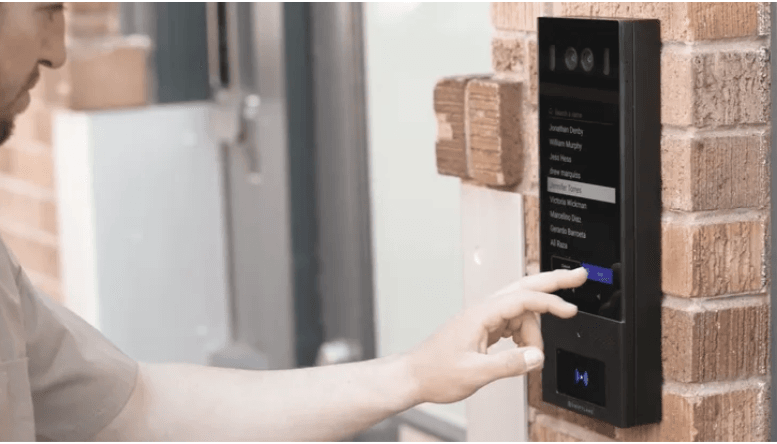

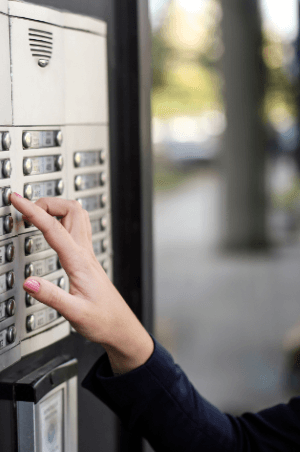
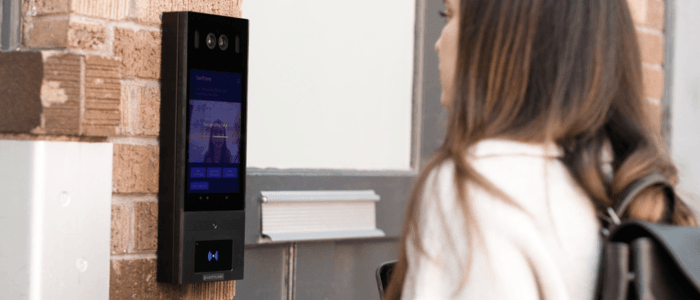
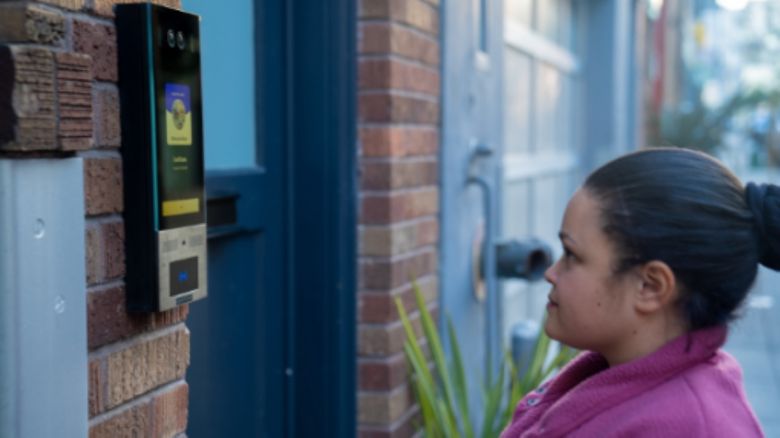
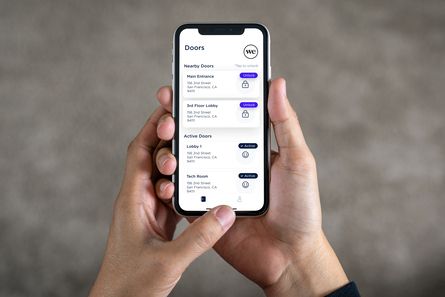

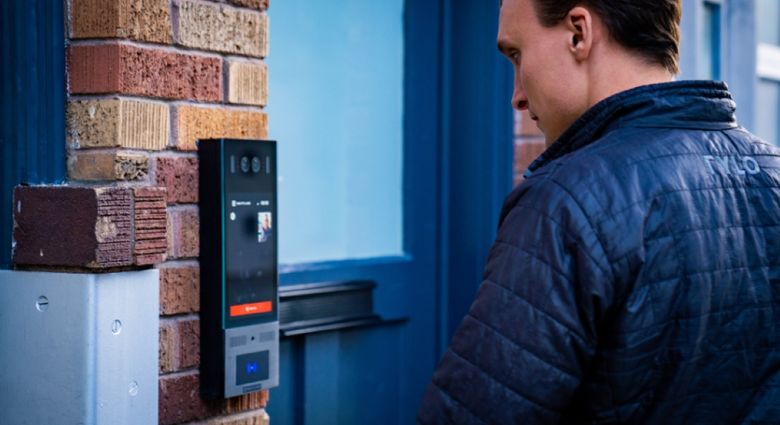

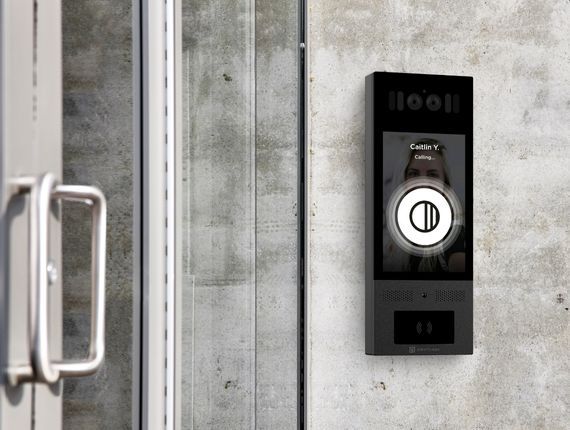
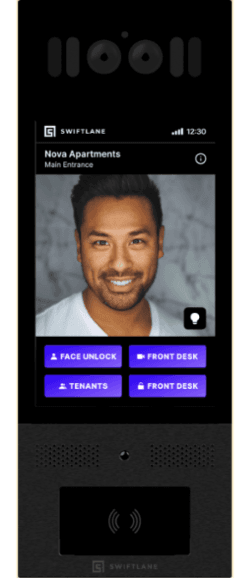
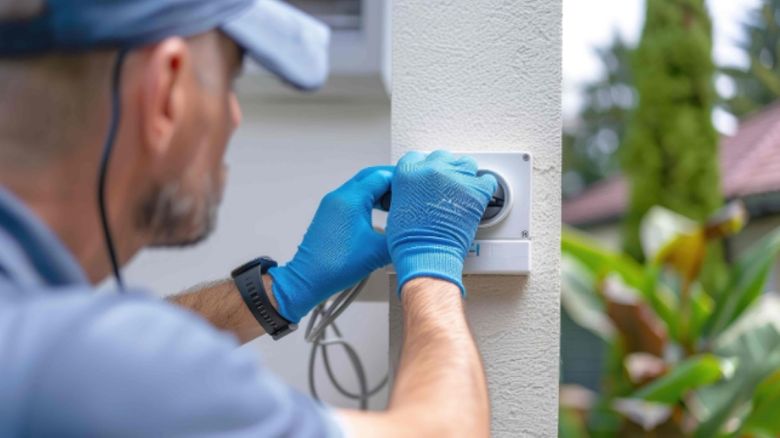
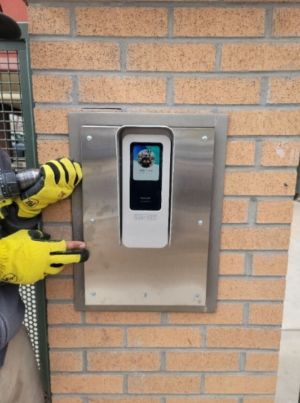
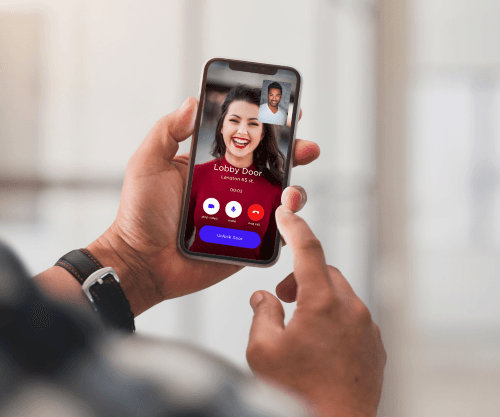



![Guide to Apartment Key Fob Systems [2025]](/static/38e0e833c81a96186ffdb81ec5a99252/59f5d/keyfob-2.png)
